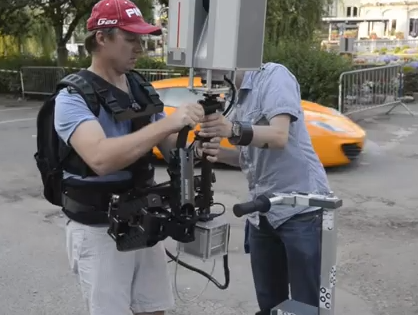P3d systems brings aboard Dr. Erwin Frei
HANNOVER, Germany – When Christian Hesse first unveiled his design for a portable laser scanning system at the 2011 Hexagon show, he made it clear that he was actively looking for development partners. It looks like he’s found one. P3d systems, the company Hesse and partner Harald Vennegeerts founded with German government start-up funds, has announced that Dr. Erwin Frei, an executive with Leica for some 20 years, and the former president and CEO of Leica Geosystems HDS (the renamed Cyra Technologies), has come aboard as an investor and shareholder.
Frei will be charged with helping p3d systems to productize Hesse’s portable scanning device and bring it to market.
The connection was made, said Hesse in an interview with SPAR, through Markus Ehm, head of laser scanning at Hesse’s service provider firm dhp:i, who had worked with Frei when Ehm was at Z+F and working with Leica on the development of the Imager 5006/HDS 6000.
“I said to Markus, ‘We definitely need some consulting. It’s very challenging to bring a product to market,’” Hesse recalled. “And he said, ‘I might know somebody.’ … We quickly experienced that Erwin is one of the most skilled and networked people in the scanning business. It was a perfect collaboration and we decided to work a little bit more together, until one day it came to a point where we talked about taking him on as a new investor.”
For Frei’s part, he said, “quite frankly I had to call it a no brainer.” He likened laser scanning’s development to that of GPS, with which he had a great deal of experience at Leica. “In the early days, it took three days to stay on a point to record with GPS,” he said. “Just to get a single point.” Then it became a few seconds in a single spot, moving all the way to the continuous GPS collection we experience today.
“I believe that’s where laser scanning is going,” he said. “It’s not there yet, definitely not, but laser scanning has to evolve in a similar way … it must go kinematic.”
As people look to increase their productivity with 3D data collection, there are two ways to help them, Frei said. One is to increase the collection speed of the scanner – “maybe we’ll see 10 million points per second at some point,” he laughed – “but that won’t solve the fundamental productivity issues that we still have. Portable types of systems are what we need, coupled with intelligence that will give the industry a boost that’s not possible with static or rapid static devices.”
Currently, there remains just a single portable scanning solution built by Hesse in existence, and you can see it here in use by Smart Geometrics’ Sam Billingsley, in Belgium, who has been helping Hesse field test the solution:
However, Hesse and Frei said this fall’s Intergeo show will be p3d’s coming out party, and there will be a product announcement for the portable scanning system, with delivery of new systems expected by 1Q 2013.
Frei said there were still some things that needed to be ironed out before the product was ready for sale.
“Surveyors need to know that when they leave the field they’ve got the data they need – we need to make sure that the ease of use is there,” Frei said.
Hesse said the collection software is completely finished and usable, but, for example, the back-end processing software is still fairly raw and under development. A GUI still needs to be developed that would, again, allow for push-button ease of use. Right now, all data gathered has to be processed in the p3d offices.
“Reliability is very important,” said Frei, “and usability is very important.”
That said, the portable scanning system, which can work with any number of scanners, has already been on a number of real-life jobs, and the feedback from those jobs is invaluable to p3d, said both Frei and Hesse.
“We can’t wait to get the systems in the hands of other users,” Frei said. “They might not use it the same way that we’re using it. We’ll learn tremendously as soon as we have the first product out. They can give us lots of feedback.”
The good news, Frei said, is that going to market with a 3D data capture device is not as hard as it once was. “There was no market” when Leica bought Cyra, Frei said. “People didn’t know anything about this technology. It was pure pioneering. Now, with the help of you guys at SPAR, actually, this market is well established. There are thousands of customers out there, who have scanners and can use this to make their scanners portable. They basically know how to use it. Going to market is not as much pioneering anymore, it’s hooking into and tapping into an existing customer base.”
“It’s another tool in the toolbox,” he continued. “That should be an interesting value proposition for customers. They can become more versatile and they can create new applications and new revenue.”






